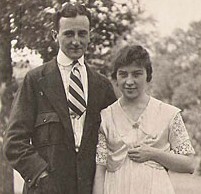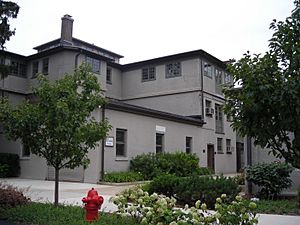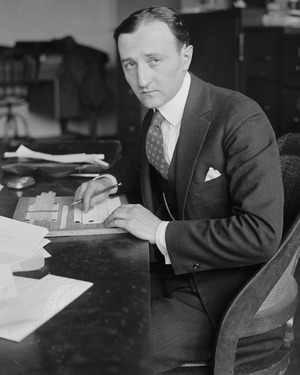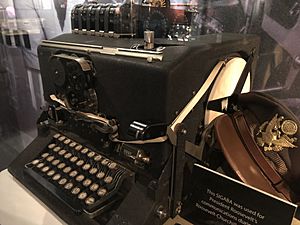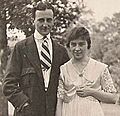William F. Friedman facts for kids
Quick facts for kids
William F. Friedman
|
|
|---|---|
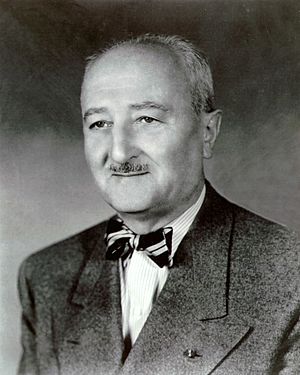 |
|
| Born |
Wolf Friedman
September 24, 1891 Chișinău, Kishinyovsky Uyezd, Bessarabia Governorate, Russian Empire
|
| Died | November 12, 1969 (aged 78) Washington, D.C., United States
|
| Nationality | Romanian, Moldovian, Russian, American |
| Occupation | Engineer |
| Spouse(s) | Elizebeth Smith Friedman |
| Children | 2 |
| Engineering career | |
| Significant advance | cryptologist |
William Frederick Friedman (born September 24, 1891 – died November 12, 1969) was a very important code-breaker for the U.S. Army. He led the research team of the Army's Signal Intelligence Service (SIS) from the 1930s into the 1950s. In 1940, his team, especially Frank Rowlett, cracked Japan's secret "PURPLE" code. This helped the U.S. learn about Japanese plans before World War II began for America.
Contents
William Friedman's Early Life
William Friedman was born as Wolf Friedman in Chişinău, a city that was then part of the Russian Empire. His father, Frederick Friedman, was a translator and linguist. In 1892, his family had to leave Russia and moved to Pittsburgh, Pennsylvania, in the United States. A few years later, his first name was changed to William.
As a child, William became interested in codes after reading "The Gold-Bug", a short story by Edgar Allan Poe. He studied at Michigan Agricultural College, which is now Michigan State University. He also received a scholarship to study genetics at Cornell University.
In 1915, William joined George Fabyan's Riverbank Laboratories near Chicago. Fabyan ran a private lab that studied many different projects. William became the head of the Genetics Department. One of his projects was to study how moonlight affected how crops grew.
Starting Work in Code-Breaking
George Fabyan was also very interested in secret messages. He believed that Sir Francis Bacon had hidden secret codes in old texts from the time of Queen Elizabeth I and King James I. A researcher named Elizabeth Wells Gallup worked on this project. She thought she found many such messages in the works of William Shakespeare. She even believed Bacon wrote Shakespeare's plays.
William Friedman was good at photography. He traveled to England several times to help Gallup photograph old manuscripts. He became very interested in this work. He also met and fell in love with Elizebeth Smith, who was Gallup's assistant and a talented code-breaker herself. They got married.
Soon, William became the director of Riverbank's Department of Codes and Ciphers. He also continued to lead the Genetics Department. During this time, Friedman wrote eight important papers about code-breaking. These papers were known as the "Riverbank Publications". In them, he described the "index of coincidence", a key mathematical tool for cracking codes.
When the United States entered World War I, Fabyan offered his code-breaking team to the government. At that time, there was no official government department for this kind of work. So, Riverbank became the main place for the U.S. government to get help with codes.
During this period, the Friedmans helped break a code used by German-funded Indian groups in the U.S. These groups planned to send weapons to India to help them gain independence from Britain. The Friedmans figured out that the code was based on a dictionary. They managed to decrypt most of the messages. Later, they found out the exact book used: an 1880 German-English dictionary.
Leading the Signals Intelligence Service
The U.S. government decided to create its own code-breaking service. Army officers went to Riverbank to learn from Friedman. To help with their training, Friedman wrote several technical guides. By early 1918, he had finished seven of them. He then joined the Army and went to France. He worked as the personal code-breaker for General John J. Pershing.
In 1920, he returned to the U.S. and published another important guide. It was called "The Index of Coincidence and its Applications in Cryptography". Many people consider this to be one of the most important works in modern code-breaking at that time. His training materials for the Army were so good that they remained secret for many years.
In 1921, William Friedman became the chief code analyst for the War Department. Later, he became the head of the Signals Intelligence Service (SIS). He held this important job for 25 years. In 1929, another U.S. code-breaking office, the American Black Chamber, closed down. Its secret files were given to SIS, and Friedman's team became even more important.
Friedman invented several terms, including "cryptanalysis", which means the study of breaking codes. He also wrote many books on code-breaking. One of these, Elements of Cryptanalysis, became the main textbook for the U.S. Army's code-breaking training.
Friedman knew that math and language skills were vital for SIS's work. He got permission to hire three men who had both skills: Solomon Kullback, Frank Rowlett, and Abraham Sinkov. All of them went on to have long and successful careers in code-breaking. He also hired John Hurt, who was fluent in Japanese.
During this time, Elizebeth Friedman continued her own code-breaking work. She became famous for helping the Coast Guard and FBI solve codes used by people illegally selling alcohol during Prohibition.
Cracking Cipher Machines
In the 1920s, new code machines were invented. These machines often used parts from typewriters and simple electrical circuits. One early example was the Hebern Rotor Machine, designed in 1915. This machine was promoted as being very secure and easy to use.
Friedman understood that these new "rotor machines" would be very important. He spent time studying Hebern's design. Over several years, he developed ways to analyze these machines. He found common weaknesses in most rotor machine designs. For example, if the rotors moved one step with each key press, or if the fastest-moving rotor was at the end of the series, it made the code easier to crack. By collecting enough coded messages and using a math test called the kappa test, he could, with great effort, break any code made by such a machine.
Using his deep understanding of rotor machines, Friedman helped create new machines that were much harder to break. The best of these was the SIGABA machine. After improvements by Frank Rowlett and Laurance Safford, SIGABA became the U.S.'s most secure code machine during World War II. More than 10,000 SIGABA machines were built. The patent for SIGABA was filed in 1944 but kept secret until 2001, long after Friedman had passed away.
In 1939, the Japanese started using a new, very secret code machine for their important diplomatic messages. This new code, which SIS called "PURPLE", was much harder than their old "RED" system. The U.S. Navy's code unit and SIS decided that SIS would try to break PURPLE.
After many months, a team led by Friedman and Rowlett made an amazing breakthrough. They figured out that PURPLE did not use rotors like the German Enigma machine. Instead, it used stepper switches, similar to those in old telephone systems. Leo Rosen of SIS then built a machine that worked exactly like the Japanese PURPLE machine, even though they had never seen the original.
By the end of 1940, SIS had built a copy of the PURPLE machine. With these duplicate machines, SIS could read more and more Japanese secret messages. One message they intercepted was sent to the Japanese Embassy in Washington, D.C. It ordered an end to talks with the U.S. on December 7, 1941. This message clearly showed that war was coming. It was supposed to be given to the U.S. State Department just hours before the attack on Pearl Harbor.
In 1941, Friedman had to go to the hospital because of the intense stress from his work on PURPLE. While he was recovering, a U.S. team visited the British code-breaking center at Bletchley Park. They gave the British a PURPLE machine. In return, the British shared details about the Enigma machine and how they were breaking its code. Friedman himself visited Bletchley Park in April 1943 and helped create the 1943 BRUSA Agreement, which was a secret deal for sharing intelligence between the U.S. and Britain.
National Security Agency Work
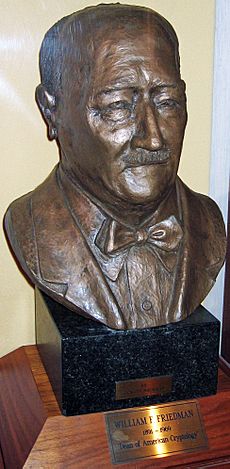
After World War II, Friedman continued to work in government code-breaking. In 1949, he became the head of the code division for the new Armed Forces Security Agency (AFSA). In 1952, when the National Security Agency (NSA) was formed to take over from AFSA, he became its chief code-breaker.
Friedman wrote a classic series of textbooks called "Military Cryptanalysis". These books were used to train new students at the NSA. His assistant, Lambros D. Callimahos, later updated and expanded these books. In his early years at the NSA, Friedman encouraged the agency to develop what might have been the first supercomputers. However, he always believed that a machine could not have the same "insight" as a human mind.
Friedman spent much of his free time trying to crack the famous Voynich Manuscript. This mysterious book is thought to have been written between 1403 and 1437. After 40 years of study, he had to admit he couldn't break its code. He could only make an educated guess about where it came from and what it meant.
In 1955, Friedman helped arrange a secret agreement between the NSA and Crypto AG. This Swiss company made encryption machines. Because of this agreement, many of the company's machines were secretly changed. This allowed the NSA to easily break the codes made by those machines.
Friedman retired in 1956. With his wife, he went back to the problem that first brought them together: studying Francis Bacon's supposed secret codes. They wrote a book called The Cryptologist Looks at Shakespeare. This book showed the mistakes in the work of Elizabeth Wells Gallup and others who claimed to find hidden codes in Shakespeare's plays.
At the NSA's request, Friedman prepared "Six Lectures Concerning Cryptography and Cryptanalysis". He gave these talks at the NSA. However, the agency later took back his reference materials from his home due to security concerns.
Later Life and Legacy
Friedman's health began to decline in the late 1960s, and he passed away in 1969. William and his wife Elizebeth are buried together in Arlington National Cemetery.
The Friedmans gave their important papers and documents to the library of the George C. Marshall Foundation. Some of this material has also been reclassified and removed by the NSA for security reasons.
William Friedman has been honored in many ways. He was inducted into the Military Intelligence Hall of Fame. A building at the NSA complex in Fort Meade, Maryland, is named after William and Elizebeth. He also received the Medal for Merit from President Harry Truman and the National Security Medal from President Dwight Eisenhower.
Friedman holds a unique record for having one of the longest-kept secret patent applications. It was for a "cryptographic system". He filed it on July 25, 1933, but it was not made public until August 1, 2000.
Friedman Hall, located at Fort Huachuca, Arizona, is also named in his honor.
William Friedman's Family
William Friedman and his wife, Elizebeth, had two children: Barbara Friedman (who later became Barbara Atchison) and John Ramsay Friedman.
Awards and Honors
- 1944: Commendation for Exceptional Civilian Service
- 1946: Medal for Merit
- 1955: National Security Medal
Images for kids
-
Bust of Friedman on display at the National Cryptologic Museum, where he is identified as the "Dean of American Cryptology".
See Also
- Cryptography
- Elizebeth Smith Friedman
- Magic (cryptography)
- Riverbank Publications


